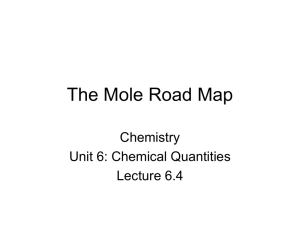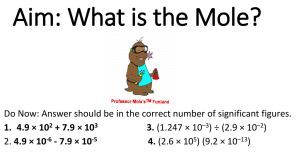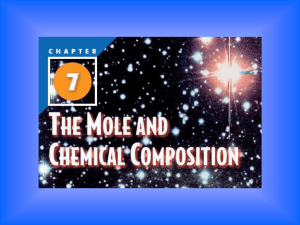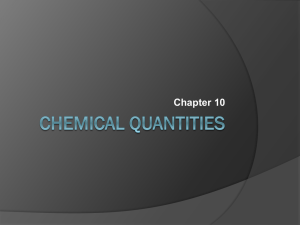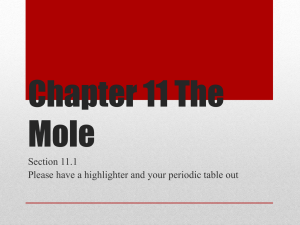File - Loreto Science
advertisement
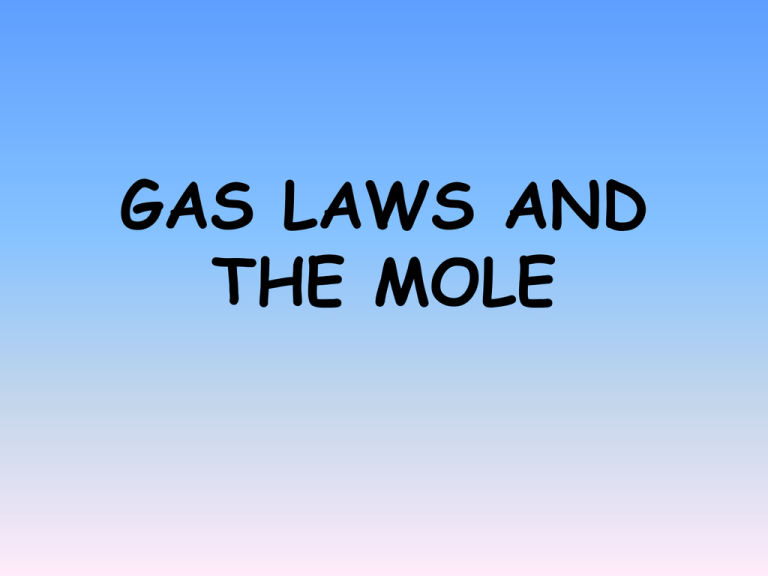
GAS LAWS AND THE MOLE The difference between solids, liquids and gases is the arrangement and freedom of movement of particles Take a Closer Look at Gases •Gases move very rapidly in a disordered fashion colliding with each other and the walls of the container (Brownian Motion) •Particles separated by relatively large distances and are easily compressed •The more energy (heat / light) you give the particles the more rapidly the move Diffusion Diffusion is the spreading out of a substance, and is due the natural movement of the particles Specified Demonstration 1 Ammonia and hydrogen chloride gases diffuse from opposite ends of the tube. When the two gases combine a cloud of ammonium chloride (NH4Cl) is formed Examples: Diffusion of gas in air / Diffusion of ink in water • Gases obey certain laws we need to study what is meant by Temperature, Pressure and Volume before looking at the laws more closely Temperature • This is a measure of the degree of hotness of an object • Two scales are used 1. The Celsius scale(also called the centigrade scale) 2. The Kelvin scale (also called the absolute scale) • The celsius scale was developed in 1742 and uses the freezing point of water as 0 and the boiling point of water as 100 • These are 2 fixed points on the scale • The kelvin scale was developed in 1848 and states 0 is the point where a gas would occupy no volume if cooled indefinitely without becoming a liquid or a solid It is called absolute 0 or 0 K Converting from Celsius to Kelvin • Temperature can be converted from celsius to kelvin by adding 273 Pressure • The is the force that the gas exerts per unit area of its container • It is measured in Newtons per meter squared N/m2 also called the Pascal (Pa) • Normal atmospheric pressure is 1 x 105Pa • As Pascals are very small Kilopascal (KPa) are also used • 1KPa = 1000Pa Volume • Volume describes the amount of space taken up by a gas • SI units for volume are m3 This is too large for laboratory scale work so we use litres (l) or cm3 • Litres are also called cubic decimetres (dm3) • 1 litre = 1000cm3 = 1 cubic decimetre Standard Temperature and Pressure • As the volume of a gas varies with temperature and pressure we need to use standard temperature and pressure (s.t.p.) when we are comparing two gases • The standards that have been chosen are Standard temperature = 273K (0⁰C) Standard Pressure = 1 x 105Pa or 100KPa • There are many different gases that behave in many different ways, some are flammable, some are coloured, some are poisonous, some are vital for life etc. • Even though gases have different chemical properties they all obey certain laws • We shall study 5 of these Gas Laws BOYLES LAW At constant temperature (T), the volume of a given mass of any gas is inversely proportional to the pressure (P) of the gas P V • This means V 1 P • Therefore if k is a constant of proportionality V = K 1 P Or pV = K See table 10.1 p 111 CHARLES LAW At constant pressure the volume of a given mass of any gas is directly proportional to the temperature V=k T • Remember T is measured in Kelvin • This law essentially states that as temperature increases volume increases as long as pressure stays the same The Combined Gas Law (General Gas Law) • Boyles law states pV=k • If the temperature stays the same and the volume changes to V2 then the pressure will change to p2 as they are inversely proportional • Thus it is true to say p1V1 = p2V2 • Similarly from Charles’ Law V1 = V2 T1 T2 These combine to form • These combine to form p1 V1 = p2V2 T1 T2 • To use this combined law see example 10.1 page 113 • Remember all temperature values must be on the K scale and the units must be the same for pressure and volume on both sides eg. If Kpa are used on the left they must also be on the right Gay-Lussac Law of combining volumes: When gases react the volumes consumed in the reaction bear a simple whole number ratio to each other, and to the volumes of any gaseous product of the reaction, all volumes being measured under the same conditions of temperature and pressure He found for example that two volumes of hydrogen combine with one volume of oxygen to give water 2H + 1O → 1H2O Avogadro’s Law Equal volumes of gases, under the same conditions of temperature and pressure, contain equal number of molecules So lets say at 300K (temp) and 100,000Nm-2 (Pressure) we have two containers one with (He) and another with carbon-dioxide (CO2). They will have the same number of molecules He CO2 So what can we take from GayLussac (GL) and Avogadro……… • Consider the reaction of Hydrogen and chlorine according to the GL law 1 H2 + 1Cl2 → 2HCl 1 volume + 1 volume → 2 volumes • Instead of volume lets do it in terms of number of molecules (N) (Avogadro) 1 H2 + 1Cl2 → 2HCl 1 molecule + 1 molecule → 2 molecules Reading Chemical Equations H2 – means hydrogen gas molecule H-H 2H – mean 2 hydrogen atoms H + H 2H2 -means 2 hydrogen gas molecules H-H + H-H Some More Examples…… H2O is 2 x H and 1 x O but 2H2O is 2 molecules of H2O CH4 is 1 x C and 4 x H But 2CH4 is 2 molecules of CH4 • Sulphur dioxide reacts with hydrogen sulphide according to the equation SO2 + 2H2S → 3S + 2H2O • What volume of sulphur dioxide would completely react with 140cm3 of hydrogen sulphide, all volumes being measured under the same conditions of temperature and pressure? The Mole The mole is the unit we use in chemistry for the amount of a substance We use moles because it is impossible to measure out molecules A mole of a substance is the amount of that substance that contains as many particles (atoms/molecules/ions) as there are atoms of 12C in 12g of 12C • Therefore 1 mole of 12C weighs 12g and contains 6 x 1023 carbon atoms • 6 x 1023 is known as Avogadros constant and is given the symbol L Avogadro's constant (L) 602000000000000000000000 particles How Big is a mole? • One mole of marbles would cover the entire Earth to a depth of fifty miles How Big is a mole? • One mole of rice grains is more than the number of grains of all crops grown since the beginning of time. So this means…… 1 mole of sodium (Na) = 6 x 1023 Sodium atoms 1 mole of Iron (Fe) = 6 x 1023 Iron atoms And…. 1 mole of Chlorine gas (Cl2)= 6 x 1023 chlorine molecules 1 mole of water (H20) = 6 x 1023 water molecules So lets look at an equation…… SO2 + 2H2S → 3S + 2H2O 1 mole + 2 moles → 3moles + 2 moles (6 x 1023 ) Molecules of SO2 + (2 x 6 x 1023 ) molecules of H2 → (3 x 6 x 1023 ) molecules of S + (2 x 6 x 1023 ) molecules of H2O How many atoms are in 4 moles of neon gas? Neon gas – Ne 1 mole of neon gas = 6 x 1023 atoms Therefore… 4 moles of neon gas = 4 x (6 x 1023) = 2.4 x 1024 neon atoms How many atoms are there in 0.15moles of sulphur dioxide? 1 mole of SO2 = 6 x 1023 molecules 0.15 moles of SO2 = 0.15 x 6 x 1023 molecules 0.15 moles of SO2 = 0.9 x 1023 molecules Every SO3 has 3 atoms (1xS and 2xO) 0.9 x 1023 molecules of SO2 = 3 x (0.9 x 1023) Atoms = 2.7 x 1023 Atoms A sample of oxygen contains 3 x 1022 molecules. How many moles is this? 6 x 1023 molecules = 1 mole 3 x 1022 molecules = 3 x 1022 moles 6 x 1023 = 0.05 moles Molar Volume of Gases • Avogadro said that under the same conditions of temperature and pressure (s.t.p.), equal volumes of gases have equal numbers of molecules (s.t.p.) standard temperature and pressure pressure = 101 325 Nm-2 = 101 325 Pa Temperature = 273 K This means….. At s.t.p. 1 mole of gas = molar volume = 22.4 l = 22400cm3 = 2.24 x 10 -2 m3 So at s.t.p. 1 mole of nitrogen (N2) occupies 22.4 l And 1 mole of CO2 occupies 22.4 l What is the volume at s.t.p. of 0.25 moles of chlorine gas 1 mole = 22.4 l @ s.t.p. Therefore…. 0.25 moles = 0.25 x 22.4 l @ s.t.p. = 5.6 l How many moles are there in 280 cm3 of nitrogen gas at s.t.p. @ s.t.p. 22 400 cm3 = 1 mole @ s.t.p. 280 cm3 = 280 moles 22400 = 0.0125 Relative Molecular Mass (M) Average mass of a molecule of a substance relative to one twelfth of the mass of an atom of 12C For an element eg. C the molecular mass is equal to the relative atomic mass For molecules it is the sum of the relative atomic masses Examples The relative atomic mass of: Carbon = 12 Iron = 55 Hydrogen gas (H2) = (2 x 1) = 2 Water (H2O) = (2 x H) + (1 x O) = (2 x 1) + (1 x 16) = 18 Measuring Relative Atomic Mass • Measured using a mass spectrometer (see chapter 2) Molar Mass The molar mass of a substance is the mass in grams of one mole of the substance. The units for molar mass are gmol-1 Examples Substance Iron (Fe) Oxygen (O2) Water (H2O) Relative Molecular Mass 55 32 18 Molar Mass 55 gmol-1 32 gmol-1 18 gmol-1 Calculations using moles Moles of X = mass of X (in grams) molar mass of X Volume of X = (Moles of X) x (22.4L) Number of particles of X = (Moles of X) x (L) L = Avogadros Constant REMEMBER YOU CAN REARRANGE THESE EQUATIONS IF YOU NEED TO
